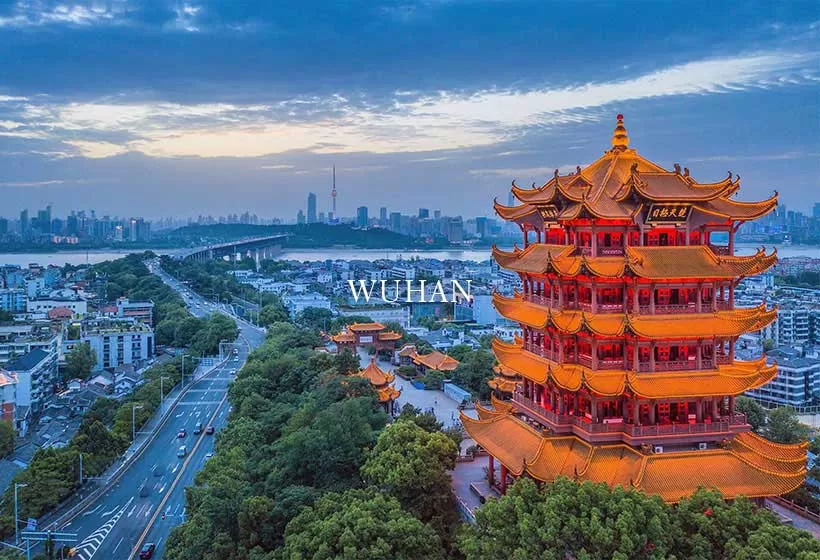Food and restaurants, what and where to eat in Wuhan
As the crossroads of nine provinces, Wuhan's culinary culture blends the fishing traditions of the Yangtze River with the bold spirit of its bustling dockside life, giving rise to a rich array of distinctly regional dishes. From the billowing steam of breakfast stalls to the glowing neon of night markets, one finally understands why Wuhan is called the "Capital of Breakfast" and a "Carb Lover's Paradise". Following are the best food and restaurant in Wuhan.
What to eat
Top 1: Hot Dry Noodles/热干面
Hot Dry Noodles is one of the most famous snacks in Wuhan, Hubei, and is celebrated as one of the "Five Famous Noodles of China". It originated in the early 20th century, created and refined by street vendors Li Bao and Cai Mingwei based on traditional alkaline noodles. Because hot dry noodles are quick, convenient, and delicious, it has become the first choice for many people in Wuhan when having breakfast.
Hot dry noodles are a type of dry-mixed noodles. The noodles themselves are alkaline noodles, complemented with sesame oil, sesame paste, chopped scallions, chili oil, and other ingredients. They are smooth, chewy, golden, and glossy, with a deliciously savory taste. The soul of hot dry noodles lies in the sesame paste, whose rich, nutty aroma gives the noodles a delicate and mellow flavor. Before eating, the noodles must be mixed thoroughly while still hot, so that the sesame paste coats them like "ants crawling on a tree". When eaten this way, they are especially fragrant and appetizing.
Top 2: Sanxian Doupi/三鲜豆皮
Sanxian Doupi is one of the main breakfast foods for Wuhan locals and a traditional folk snack with distinctive Wuhan characteristics. Square and thin in shape, golden yellow in color, and richly aromatic, it was originally a festive dish specially prepared by Wuhan people during holidays and later became a common breakfast item.
In Wuhan, the sanxian doupi from Laotongcheng has the longest history and enjoys the greatest fame, earning the title of "King of Doupi". Tender doupi (bean skin) wraps around a filling of cooked glutinous rice, fresh pork, egg, mushrooms, dried tofu, and other ingredients, then are pan-fried to perfection. The resulting doupi is crispy on the outside and soft inside, golden and glossy, oily yet not greasy, with a taste that is both delicate and fragrant.
Top 3: Fish Paste Soup Noodles/鲜鱼糊汤粉
Fish Paste Soup Noodles is a famous specialty snack enjoyed across Wuhan three towns, regarded as Lamb Paomo of Wuhan people, and when paired with crispy youtiao, it perfectly embodies the distinctive dockside culture of the city. The soup is made by simmering wild small crucian carp until even the fish bones nearly dissolve, allowing the rich umami of the fish to completely infuse the broth. Enhanced by a dash of pepper, the flavor is fully awakened. Although rice noodles are the main staple, the true star is the freshly fried youtiao.
Golden and crispy, the youtiao is torn into small pieces and soaked in the hot fish broth. Once the youtiao have soaked up the broth, take a bite, the rich soup hidden beneath the crispy exterior mingles with the aroma of the youtiao, bursting in your mouth and delivering a deeply satisfying sensation.
Top 4: Steamed Wuchang Fish/清蒸武昌鱼
In Wuhan, a province known as a land of fish and rice, Wuchang fish represents the highest form of hospitality at local banquets and is famed both in China and abroad as the "first dish under the Chu sky".
Wuchang fish, also called Megalobrama amblycephala, is named after originating from Liangzi Lake in Ezhou (ancient Wuchang). It has a small head and long body, with abundant fat and exceptionally tasty flesh. Over time, the techniques for preparing Wuchang fish have continuously improved, with steamed Wuchang fish being particularly distinctive. The finished dish maintains the fish's whole shape, with a bright white color, glistening like jade. The fish body is garnished with red, white, and black toppings, making it elegant yet vibrant. The taste is fresh, with clear broth that preserves the original flavors, light and aromatic, accompanied by julienned ginger and sesame oil, filling the air with an enticing fragrance.
Top 5: Lotus Root Soup with Pork Ribs/排骨藕汤
Lotus Root Soup with Pork Ribs is a famous dish from Hubei, the "province of a thousand lakes", a land of waterways, and also known as the "hometown of lotus root". In Wuhan, there is a saying: "No banquet is complete without soup." At any feast, the highlight is always a pot of fresh, rich, and fragrant soup. Especially when made with Caidian lotus root, praised as a "treasure of the water", this lotus root and pork rib soup is full of local character and embodies the essence of Jingchu culinary culture.
When a steaming bowl of lotus root soup with pork ribs is brought to the table, its rich aroma immediately fills the air. The broth is milky white and thick, the pork ribs tender and falling off the bone, while the lotus root is soft, glutinous, and fragrant. A sip of the hot soup delivers both the refreshing sweetness of the lotus root and the savory richness of the pork, making it an utterly enjoyable experience.
Top 6: Mianwo/面窝
Mianwo is one of Wuhan's unique and famous snacks, much like hot dry noodles, and is also a beloved choice for breakfast among locals. Simple to make, it can be found in nearly every street and alley across Wuhan three towns. It is considered the undisputed golden sidekick of the Wuhan breakfast scene, only with mianwo alongside hot dry noodles or Fish paste soup noodles can a meal truly be called a perfect breakfast.
Made by grinding soybeans and japonica rice into a batter, it is then poured into a special mold and deep-fried into a donut-like shape. Once fried to a golden hue, it is sprinkled with sesame seeds and a touch of salt. The result is a mianwo that is golden, crispy, aromatic, and tender all at once. Its texture is delightfully unique, when eaten, it combines crispy, crunchy, and soft sensations. The thicker parts are fluffy and soft, while the thinner edges are light and crisp, creating a flavor and mouthfeel all its own.
Top 7: Huangpi Bean Shreds/黄陂豆丝
Huangpi Bean Shreds is a traditional snack from Huangpi District in Wuhan, and ranks among the eight famous dishes of Wuhan. Made from mung beans and rice ground into a batter, it is cooked into thin sheets and then cut into fine shreds, with a delicacy that is tender in texture and rich in nutrients.
Over time, bean shred has evolved into various cooking styles such as stir-frying, boiling, steaming, and deep-frying. Classic preparations like dry-fried bean shred and braised paste bean shred have been passed down to this day. Among them, the most renowned bean shred is Lao Qianji's beef bean shred on Qinglong Lane in Wuchang. It is a signature dish of Wuhan, once favored by Mao Zedong himself. The beef is tender and succulent, the bean shreds are soft and moist, and together they create a distinctive, memorable flavor.
Top 8: Wuhan Duck Neck/武汉鸭脖
Duck neck on its own has little flavor and might seem hardly worth eating. Yet after being cooked with chili peppers, star anise, and dozens of other spices, it has astonishingly become one of Wuhan people's favorite delicacies with endless aftertaste. Its aroma is tantalizing, the taste stimulating, and the meat spicy and numbing. Unlike duck gizzards or duck liver, which can be eaten in a single bite, the joy of eating duck neck lies in savoring it slowly, gnawing and chewing to relish every layer of flavor. At the end, there's a special satisfaction in giving a loud slurp to suck out the marrow from the bones.
Where to eat
Top 1: Cai Lin Ji Since 1928/蔡林记热干面
"Cai Lin Ji" brand was founded in 1928. Through the hard work and dedication of several generations, Cai Lin Ji grew from a single noodle shop into a diversified catering enterprise producing a variety of specialty snack products. It has become a household name in Wuhan and across the land of Jing-Chu, known as a time-honored brand with a history spanning a century.
Cai Lin Ji hot dry noodles are smooth, chewy, glossy, aromatic, and savory. Even before tasting, their inviting fragrance whets the appetite; once eaten, the rich aroma fills the air and leaves an endless aftertaste. Widely praised by locals, it is celebrated as one of the signature snacks in Wuhan.
- Recommended: hot dry noodles, Sanxian Doupi, Lotus root soup with rork ribs, Shumai, Xiangyang beef noodles
- Operating Hours: 07:00 AM – 10:00 PM
- Address: No. 6-8, Complex Building, Hubu Alley, Wuchang District, Wuhan
- Telephone: 18986135822
Top 2: Dazhonghua Restaurant/大中华酒楼
Dazhonghua Restaurant is a fish-specialty restaurant that enjoyed renown in Wuchang during the 1930s and 1940s, a reputation that continues to this day. After the liberation of Wuhan, the restaurant's business grew further. Thanks to a connection with Mao Zedong's poetry, Dazhonghua's fame soared and spread far and wide.
Dazhonghua is a time-honored culinary brand in Wuhan with a history of 93 years. In its early days, it mainly featured Anhui cuisine. However, following the popularity of Wuchang fish, it transformed into a restaurant specializing in authentic Hubei cuisine, long standing as a leader in Wuhan's dining scene.
- Recommended: steamed Wuchang Fish, lotus root soup with rork ribs, Mianyang three steamed dishes, beef bean shreds
- Operating Hours: 10:30 AM – 02:00 PM & 04:30 PM – 09:00 PM
- Address: No. 908, Xiongchu Avenue, Hongshan District, Wuhan
- Telephone: (027)87177788
Top 3: Sijimei Tangbao/四季美汤包
Sijimei is a time-honored Chinese brand established in 1922. Its name "Sijimei", meaning "delicacies in all four seasons", reflects the shop's year-round offerings, spring rolls in spring, cold dishes in summer, stir-fried mitten crabs in autumn, and crisp pastries in winter, bringing it thriving business. Later, with master chefs such as Zhong Shengchu crafting Jiangsu-style xiaolong tangbao (soup-filled baozi) adapted to Wuhan tastes, the shop earned high praise from customers and came to be known as the "King of Tangbao", gradually transforming into a specialty restaurant mainly serving xiaolong tangbao.
- Recommended: Sijimei Tangbao, hot dry noodles, Zhajiangmian, paste rice wine
- Operating Hours: 08:00 AM – 09:30 PM
- Address: No. 69-3, Minzhu Road, Wuchang District, Wuhan
- Telephone: 13774652928
Top 4: Laotongcheng Restautant/老通城
Laotongcheng is the name of a large restaurant located at the intersection of Zhongshan Avenue in Hankou, famed for serving the famous local snack sanxian doupi, earning it the title "King of Doupi". Founded in 1931, the restaurant improved upon the traditional Hubei folk snack doupi and paired it with sweet dishes to suit local tastes, gaining great popularity. Visitors from other regions and foreign guests coming to Wuhan all take delight in having the chance to taste Laotongcheng's doupi.
- Recommended: Laotongcheng Sanxian Doupi, paste rice wine
- Operating Hours: 07:00 AM – 07:00 PM
- Address: No. 677, Zhongshan Avenue, Qiaokou District, Wuhan
- Telephone: 13277910668
Top 5: Hubu Lane/户部巷小吃街
Hubu Lane, located in Wuchang District, Wuhan, is about 150 meters long and 8 meters wide, a vibrant street known for its blend of local snacks, leisure, shopping, and entertainment, and is hailed as the "No. 1 Lane for Wuhan Snacks". A popular local saying goes, "Start your morning at Hubu Lane". The Lane has become a symbol of Wuhan's breakfast culture and a microcosm of old Wuhan.
Dating back to the Ming Dynasty, Hubu Lane is lined with traditional brick-and-wood houses that still retain much of their historical charm. Thanks to its proximity to the river docks, the lane has always been a bustling hub of traffic and activity. The hardworking locals here have perfected the art of fast, fresh, delicious, and hot Wuhan snacks, which have delighted crowds and earned the alley a lasting reputation that endures to this day.
- Recommended: hot dry noodles, fish paste soup noodles, mianwo, sanxian doupi, Jingwu duck neck, beef been shreds
- Operating Hours: 00:00 AM – 12:00 PM
- Address: Hubu Lane, Wuchang District, Wuhan
GREAT FAMILY CHINA TOUR
JULY 2024 We wanted to thank Grace at China Culture tour for organizing a great tour of China. We enjoyed our Beijing - Xian-Chengdu -Guilin -Yangshuo - Shanghai trip. Our local guides Bruce in Beijing, Susan in Xian, Jane in Chengdu, Mike in Guilin and Mary in Shanghai took care of us…read more details »
Teng Han L from SINGAPORE
Ready to Create a Unique Dream Travel?


